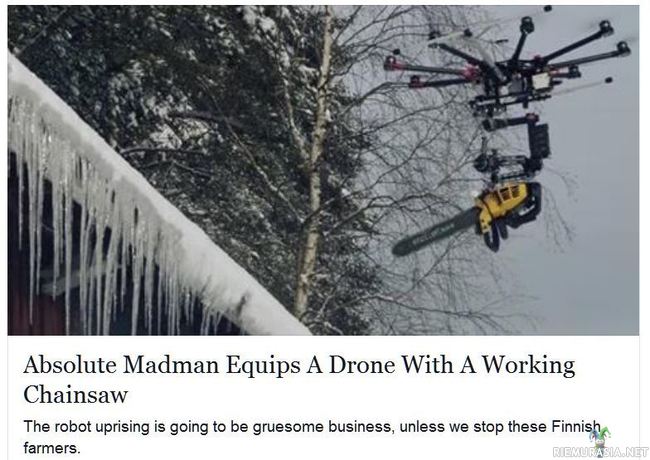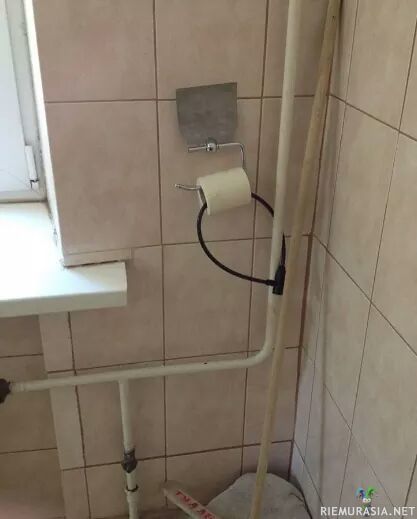
*edit Had the wrong link on the copy list ^^
ah here...

I know, it looks like photoshop but it ain't.
https://en.wikipedia.org/wiki/Maman_(sculpture)
I have seen a variation of that in canda outside one of their museums.
ah here...

I know, it looks like photoshop but it ain't.
https://en.wikipedia.org/wiki/Maman_(sculpture)
ah here...

I know, it looks like photoshop but it ain't.
https://en.wikipedia.org/wiki/Maman_(sculpture)
Likes:
Degiance and Wyntyr

*shifty eyes* Wasn't me...
You also got the problem of when the blade gets stuck or jammed into a tree and how that affects the drone's flight.
I have seen a group working on using a hand-saw/table-saw blade instead.
Yeah I know this was more of gag than something serious but... There is a lot of people trying to build a reliable version of this. A stable platform for the blade is hard when the pilot also needs to be aware of the drone's rotors which means you got keep the blade outside the rotors while also dealing with the CG problem that entails. The other problem is the angle of the cut. You also have to have the capability of changing the blade angle without needing to move the entire machine.
You also got the problem of when the blade gets stuck or jammed into a tree and how that affects the drone's flight.
I have seen a group working on using a hand-saw/table-saw blade instead.
You also got the problem of when the blade gets stuck or jammed into a tree and how that affects the drone's flight.
I have seen a group working on using a hand-saw/table-saw blade instead.
Now to post something cute or funny...
...
...
...
...
Ah!

I just had to do a star wars related pun i just had to...
saws on drones!
orange: labels
white: thing
black =: because excess " " are removed
carrying arm=servo====arm
=\======== /______/_
=\=======/=0]=/==\==\
========[ = ]=0===} [=] -clamp on piston
======== \= ]=/\=_/ \
=========== /= \== \
=========motor=\==sawblade (extended, mounted below or above clamps).
=========on===fixed clamp
=========piston
Last edited:
wonder if it'd work to have the saw and a clamp on an arm. get rid of branches near the place you want to saw with a chain-naginata or a drone with sharp exposed metal propellers, then the saw-drone flies up, extends the arm and clamps it around the tree. then a rotary saw extends into the space within the clamp. because the saw is on the side of the drone, the tree will topple away from it.
orange: labels
white: thing
black =: because excess " " are removed
carrying arm=servo====arm
=\======== /______/_
=\=======/=0]=/==\==\
========[ = ]=0===} [=] -clamp on piston
======== \= ]=/\=_/ \
=========== /= \== \
=========motor=\==sawblade (extended, mounted below or above clamps).
=========on===fixed clamp
=========piston
orange: labels
white: thing
black =: because excess " " are removed
carrying arm=servo====arm
=\======== /______/_
=\=======/=0]=/==\==\
========[ = ]=0===} [=] -clamp on piston
======== \= ]=/\=_/ \
=========== /= \== \
=========motor=\==sawblade (extended, mounted below or above clamps).
=========on===fixed clamp
=========piston
Likes:
Degiance
wonder if it'd work to have the saw and a clamp on an arm. get rid of branches near the place you want to saw with a chain-naginata or a drone with sharp exposed metal propellers, then the saw-drone flies up, extends the arm and clamps it around the tree. then a rotary saw extends into the space within the clamp. because the saw is on the side of the drone, the tree will topple away from it.
orange: labels
white: thing
black =: because excess " " are removed
carrying arm=servo====arm
=\======== /______/_
=\=======/=0]=/==\==\
========[ = ]=0===} [=] -clamp on piston
======== \= ]=/\=_/ \
=========== /= \== \
=========motor=\==sawblade (extended, mounted below or above clamps).
=========on===fixed clamp
=========piston
orange: labels
white: thing
black =: because excess " " are removed
carrying arm=servo====arm
=\======== /______/_
=\=======/=0]=/==\==\
========[ = ]=0===} [=] -clamp on piston
======== \= ]=/\=_/ \
=========== /= \== \
=========motor=\==sawblade (extended, mounted below or above clamps).
=========on===fixed clamp
=========piston
I have seen a drone with clamp + saw. The problem is that branches or tree trunks tend to fall in unpredictable fashion the higher up in the air that you are cutting. It's the reason why people in the profession ties up the wood they are cutting so a guide on the ground can get it down in a predictable manner.
You also need a clamp to release extremely fast to make that work (There is bunch of high pressure valves that could help there but that increases the weight of the drone which decreases flight time.) You don't want the cut piece of wood to get caught in the clamp as it's opening which would be harmful to a drone's flight.
I was talking about this with a crew that was removing the trees at my workplace. They talked about a presentation where multiple drones were used to do the job. Problem was the time it took and the expense of each drone and it's upkeep cost make the idea ludicrous to them. The idea behind it is sound, it just impracticable at this point.
Last edited:








